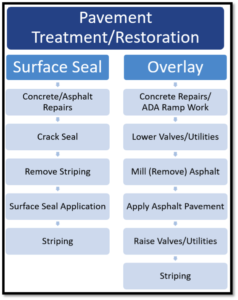Current project map
"The right treatment, on the right road, at the right time, with the right contractor, for the right price."
The City of Glendale’s Transportation Department is continuously working to improve and maintain its roadway network. Maintaining a strong network of streets is beneficial to everyone at the regional and local level for connectivity, safety and economic growth.
The current roadway network is comprised of approximately 770 centerline miles of roadway which is nearly 18 million square yards of asphalt and concrete surfacing. It is estimated that the average complete replacement cost for a major roadway is between $5.0-$6.0 million per mile. This indicates a very large amount of funding invested in pavement roadway networks nationwide and specifically within the City of Glendale. Given the high costs of reconstruction, it is imperative to maintain and extend the life of the existing pavement surface to the maximum extent possible.
The city has developed a Pavement Management Program (PMP) to best address street pavement needs. The American Public Works Association defines pavement management as a systematic method for routinely collecting, storing, and retrieving data and information needed to make maximum use of limited resources. The benefits of pavement management are numerous, including rational resource allocation, optimal use of funds, pavement rehabilitation cost reductions, pavement treatment selections, and pavement life extensions. A PMP will ultimately enable best practices for pavement needs that emerge over time.
Properly maintaining our City streets is a major task. As such, the PMP consists of the rehabilitation of poor and deteriorating streets within the City of Glendale with the application of common treatments as well as other innovative pavement preservation methods. The City of Glendale regularly evaluates the condition of roads and streets to assess the need for maintenance or repair, in addition to prioritizing and scheduling how this takes place. The plan to extend the overall life-expectancy of the City of Glendale’s streets through the most efficient and cost-saving measures is carried out through a series of pavement preservation strategies.
The PMP goal with currently available resources is to touch between 110-130 miles of Glendale streets per year in perpetuity.
Our PMP toolbox includes:
-Crack Seal
-Asphalt Rejuvenator
-Sealcoats (such as Polymer Modified Surface Seal)
-Slurry Seal
-Micro Seal
-Fractured Aggregate Surface Treatment (FAST)
-FAST + Sealcoat
-Cape Seal (FAST + Slurry or Micro Seal)
-Thin Overlay (1" to 1.5"); May be considered a "Partial Reconstruction"
-Mill & Overlay (1.5" plus); May be considered a "Reconstruction" to a "Full Reconstruction"
The PMP process includes identifying streets, respective treatment types, contractor scheduling, pre-treatment measures, and placement of the final surface treatment. It is a multi-dimensional undertaking. Construction activities are invariably not always going to occur as originally scheduled. Other factors include weather delays, equipment breakdowns, interruptions to material supply chains, unknown utility conflicts, commitments to other municipalities by the contractor, additional work/material required on streets ahead of other streets in queue, and to a lesser extent staffing resources.
The City sincerely apologizes for any inconveniences and frustrations that occur due to delays or continued postponements. We are not always going to be perfect all of the time; but please rest assured that we do not take delays very lightly and make monumental efforts to bring activities back on track for a successful PMP implementation process. The lines of communication are always open and we encourage you to use them, but most importantly, we appreciate your support too!
Current project map; A new map of areas to be treated between July 2024 to June 2025 is posted with specific surface treatments.
This updated Pavement Management Program map includes all coverage (approx. 115 miles) identified for the 2025 Fiscal Year.
A report has been developed that documents the state of our City street network with details pertaining to surface conditions, targeted Pavement Condition Index, and available and proposed budget amounts. Please click on the image below to view the results of the of the current Pavement Management Program Plan and Citywide Street network pavement conditions.
 In addition to the report above, a dashboard of the 10-Year Pavement Management Plan that includes all of the City street segments that will touched by the Plan has been created for your information. On it, you can zoom in on any street of interest and displayed will be the street name, its assigned Fiscal Year, and a general treatment category (Surface Treatment, Partial Reconstruction, or Reconstruction). Click on the image below to launch the dashboard:
In addition to the report above, a dashboard of the 10-Year Pavement Management Plan that includes all of the City street segments that will touched by the Plan has been created for your information. On it, you can zoom in on any street of interest and displayed will be the street name, its assigned Fiscal Year, and a general treatment category (Surface Treatment, Partial Reconstruction, or Reconstruction). Click on the image below to launch the dashboard:

For more information on the City of Glendale’s Pavement Management Program, please contact our project hotline at 602.532.6250.
`